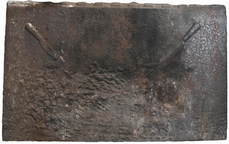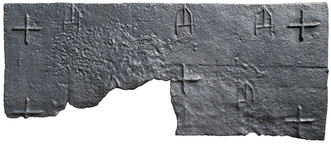-
742
Description: Rectangular with canted top corners; twisted rope edging all round except base: plain plate with two stamps of an iron firedog with twisted neck and shield bearing letters HN and crossed staples; firedogs have columnar capitals; fleur de lys stamp repeated six times, singly at each end, in star pattern in middle; stamps have twisted wreaths.
Notes: The initials HN probably refer to Henry Nevill, the crossed staples being a badge of the Nevill family. Henry Nevill occupied Mayfield furnace from about 1585 until 1599. One of two variants (see no. 393) with the same firedogs and fleurs-de-lys; other firedogs in a very similar style are known.
Inscription: HN HN
- Decoration tags:
- rectangular with canted top corners (shape)
- rope (edging)
- simple stamps
- carved stamps
- heraldic
- text
- objects
Manufactured: in the late-16th century possibly at Mayfield Furnace in the Weald area of England.
Current location: Victoria & Albert Museum, Cromwell Road, Kensington & Chelsea, Greater London, England.
Museum number: 11.1900 (part of the Victoria & Albert Museum museum group)
-
1279
Description: Plain rectangular shape with chamfered and embattled top edge; impression of a utilitarian, domestic knife inclined, blade down, at an angle of about 45 degrees from inside the top corners; the knife measures about 20.5cm in length.
Notes: An unusual, if not unique, top edge. The form of the knife suggests a late-16th or early-17th century date. The uneven surface of the lower part of the fireback may have been caused by the pouring of the molten metal and the consequent disturbance of the casting sand of the mould.
- Decoration tags:
- rectangular (shape)
- none (edging)
- simple stamps
- objects
Manufactured: in the late-16th to early-17th century in the Weald area of England.
Current location: in private hands, Wadhurst, East Sussex, England.
-
797
Description: Rectangular; twisted rope edging (top and sides); three impressions of an ornate firedog, each incorporating lion’s legs, above it a pedestal with a lion’s head, surmounted by a caryatid, a shield shaped cartouche over its lower trunk, and with a floral vase headdress. The dog impressions are not evenly stamped, the middle one lying to the right.
Notes: The firedogs are much more elaborate than those customarily used as stamps on firebacks and indicate a later date; they probably included brass elements and were possibly French.
- Decoration tags:
- rectangular (shape)
- rope (edging)
- simple stamps
- objects
Manufactured: in the late-16th to early-17th century in the Weald area of England.
Current location: in private hands, Wisborough Green, West Sussex, England.
- Attached to series:
- Firedog stamp firebacks
- Metalware stamp firebacks
-
636
Description: Rectangular; no edging; quasi-symmetrical arrangement of crosses and buckle outlines: a cross at each corner and one to right of middle, three buckles along the top and three buckles in triad, level with, and below, the central cross; two horizontal plank lines; lower left part of back missing due to wear and corrosion. The fireback has a small accumulation of iron slag on the reverse side, probably caused by a failure, by the founder, to tap off all the slag from the furnace hearth before casting.
Notes: The buckles, which could have been stamped using a branding iron, suggest a connection with the Pelham family. This is the fireback noted in 1861 at Warbleton Priory, Sussex, which the Pelhams endowed in 1413; the priory was dissolved in 1535 suggesting that the fireback dates from before then. The excrescence, left of centre, on the surface of the fireback was probably caused by molten iron being poured from a ladle into the sand mould and displacing some of the sand.
- Decoration tags:
- rectangular (shape)
- none (edging)
- simple stamps
- carved stamps
- planklines
- heraldic
- objects
Manufactured: in the early- to mid-16th century in the Weald area of England.
Current location: Anne of Cleves House, Southover High Street, Lewes, East Sussex, England.
(part of the Sussex Archaeological Society museum group)
- Attached to series:
- Pelham family firebacks
- Metalware stamp firebacks



